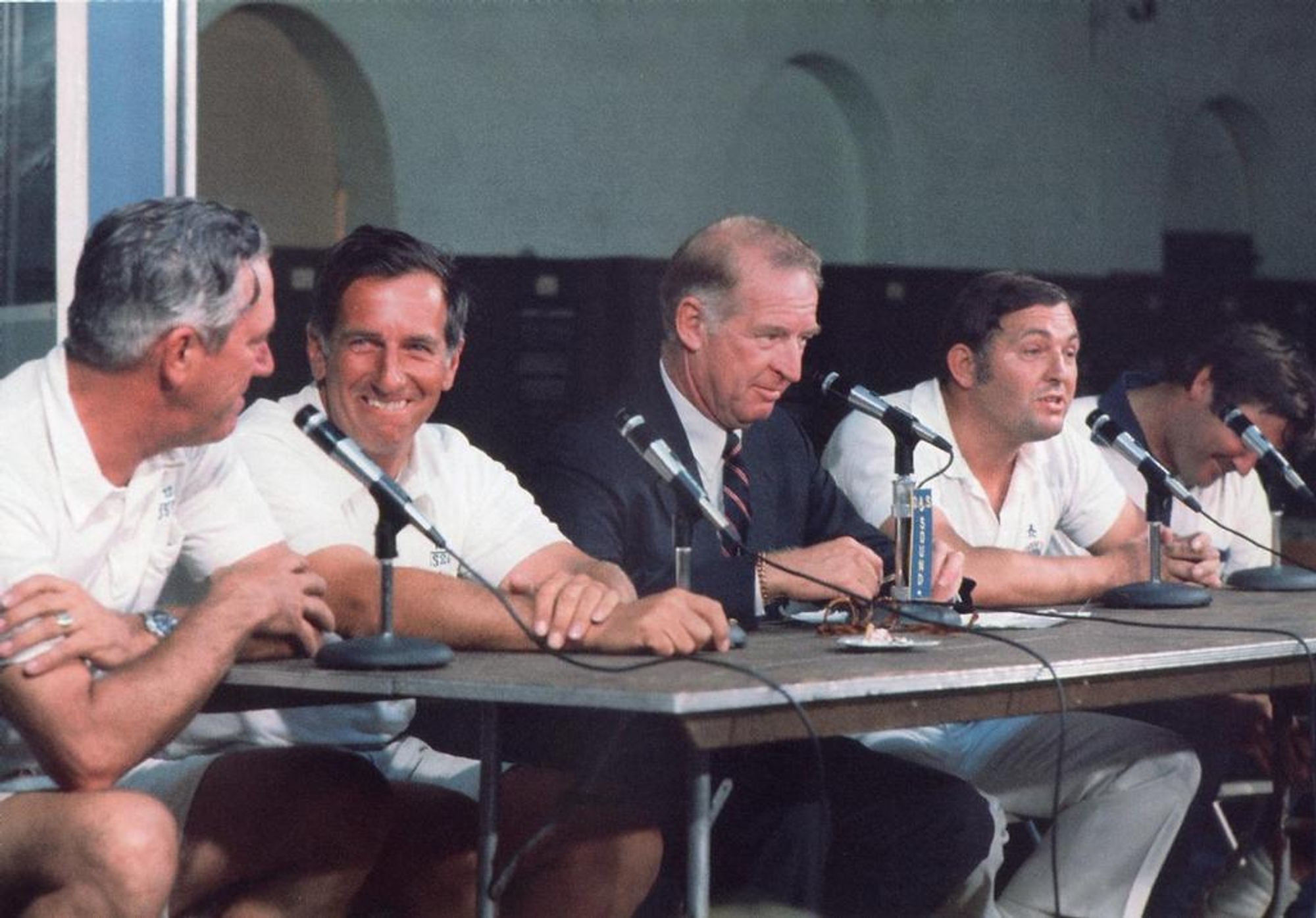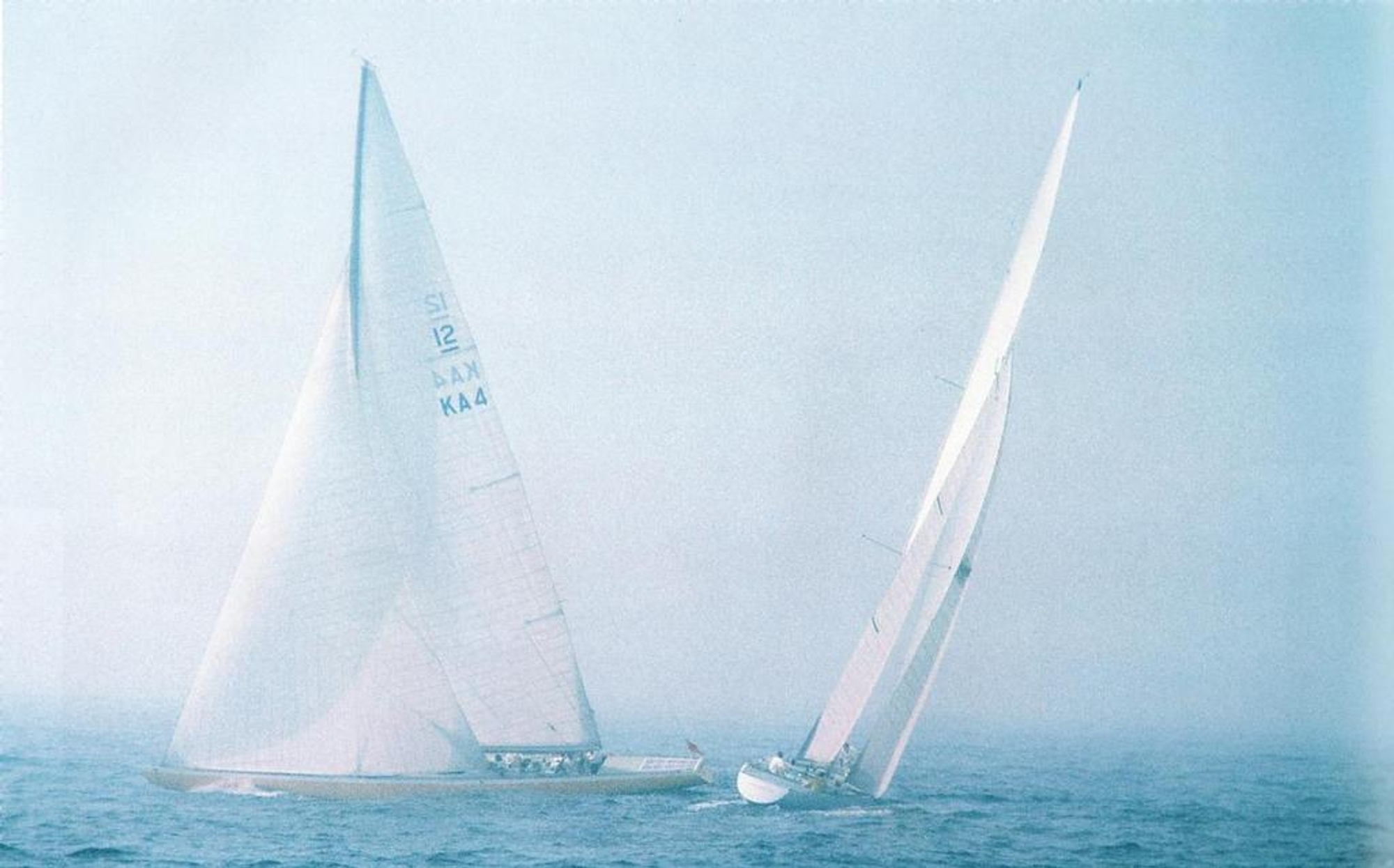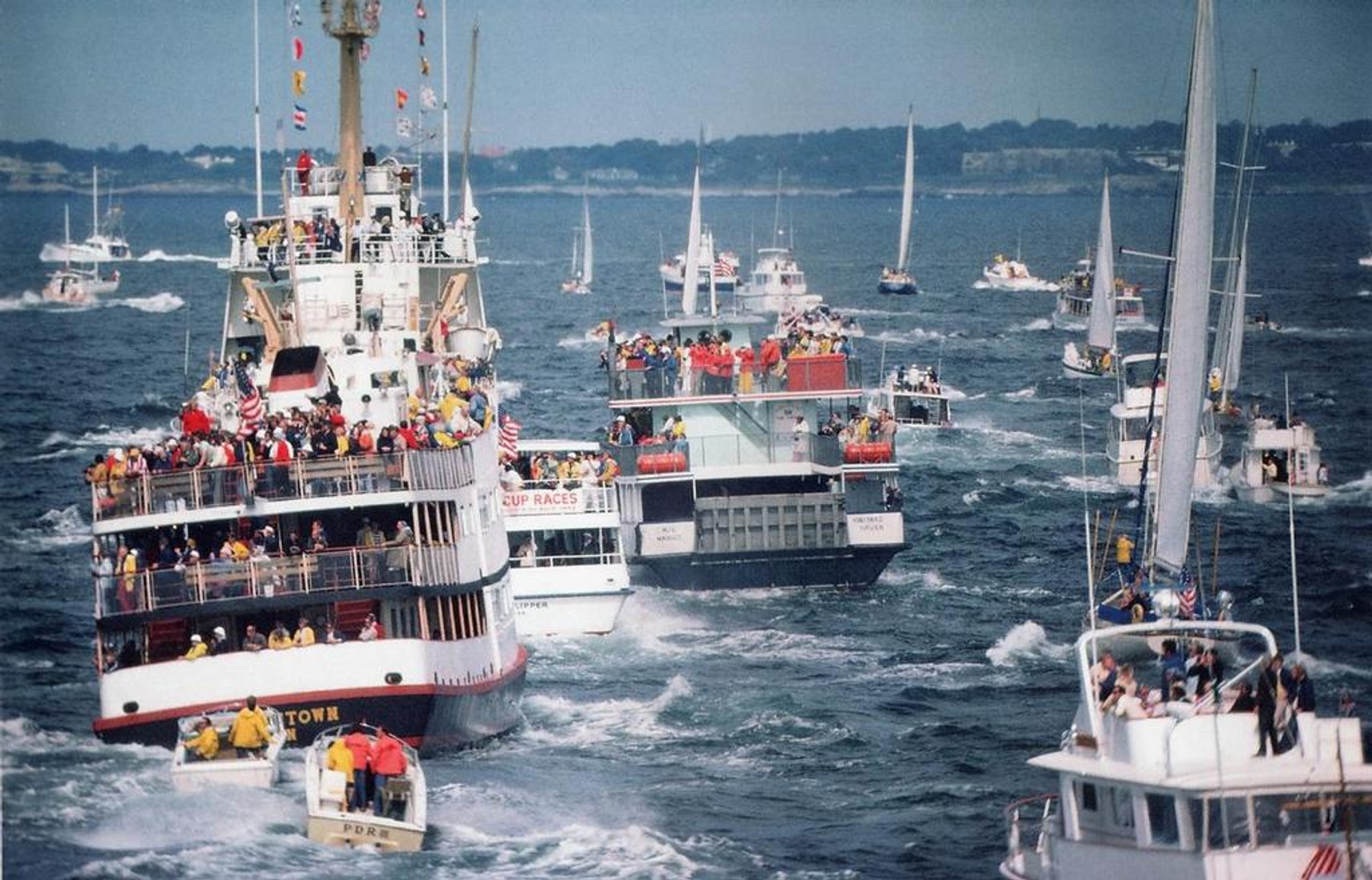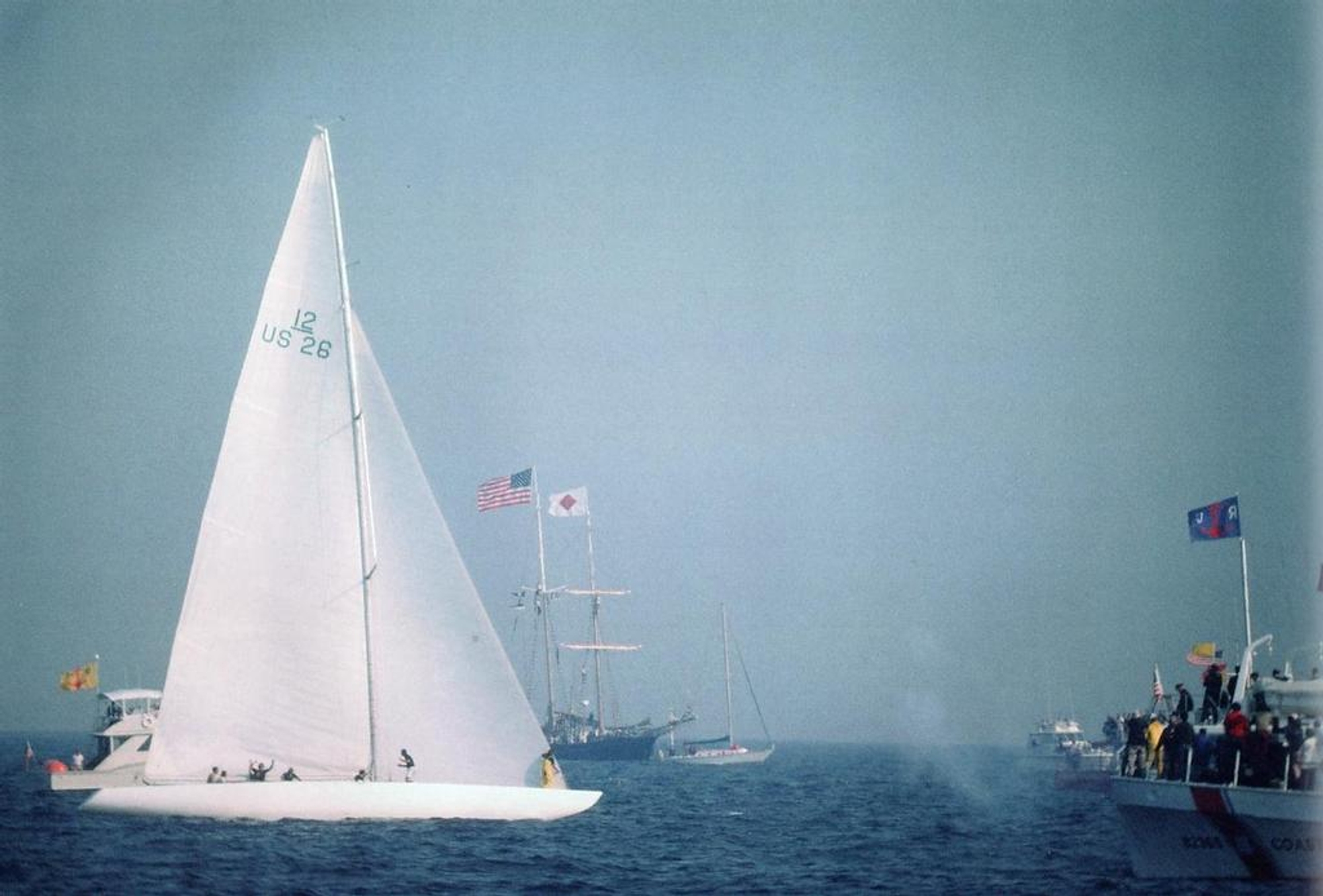THE MIGHT OF COURAGEOUS
As a blueprint for the modern-day America’s Cup, the summer of 1974 was the dawn of a new era in the regatta that featured individuals who would dominate the competition for decades to come whilst adding a colour and vibrancy that propelled the prestige of the Cup to lofty heights.
The global backdrop however was dire with the oil crisis leading from the Saudi Arabian reaction to the Yom Kippur War driving oil prices up 300% from October 1973 to March 1974 whilst the global stock-markets were in dire ‘bear market’ conditions all through January 1973 to December 1974, particularly affecting the United Kingdom’s market and having the effect on its subsequent ability to challenge for the Cup. Indeed, the Royal Thames Yacht Club had been accepted as Challenger of Record, but ultimately no challenge was able to attract the wherewithal to compete. The club duly completed its duties for the challengers, nonetheless.
However, into this trying economic landscape stepped two strong challenger syndicates whilst no less than four very able defence syndicates were corralled by the New York Yacht Club. The America’s Cup, so long the preserve of gentleman yachtsmen, was about to be changed forever as a new breed of participants came forward, brash and uncompromising, it was a memorable regatta both on and off the water. With Sir Frank Packer stepping away from the Cup (he passed away on 1st May 1974 from heart failure), the Australian mantel was taken up by Alan Bond, a former sign-writer with little formal education who was finding considerable success in the property world.

Ted Hood (second from left) at a media conference in the 1974 America’s Cup, others are Bob McCullough (left), Bus Mosbacher (centre), Alan Bond, and Ben Lexcen Paul Darling Photography Maritime Productions
Bond’s Yanchep Sun City, once a small crayfishing settlement north of Perth was developed with an eye on hosting the 1977 America’s Cup and the entrepreneur was doing everything he could to promote it. An entry into the America’s Cup felt like a perfect marketing opportunity, but the Royal Perth Yacht Club were the challenging club under whose flag Bond’s yacht ‘Southern Cross’ challenged and in Bob Miller (later Ben Lexcen), Bond found a kindred spirit and someone who would, some years later, ultimately change the course of the Cup forevermore.
Meeting the Australian challenge was Baron Marcel Bich, the flamboyant French manufacturing entrepreneur who called on one of the greatest legends of the sport of sailing, the Danish Olympic hero Paul Elvstrom, to build and lead the team. French yachtsmen were incensed at the decision. Bich had begun his ‘France’ syndicate in 1970 to provide experience for French sailors, acquiring a quiver of 12-Meters based out of the Yacht Club d’Hyères, but having Elvstrom call the shots and hiring in Scandinavian sailors and designers quickly sat uneasily with him. The Dane commissioned a radical design from the board of Jan Kjaerulff that commenced build at the Egger Yard in Pontarlier, the commune of Bourgogne-Franche-Comté, but long before completion, Bich and Elvstrom parted ways and with the clock ticking before racing was due to commence, the French were left with only the 1970 ‘France’, which was acknowledged as not being fast even in its prime, in which to compete.
For the Australians however, Miller had designed what was thought to be a step-on from Gretel II which Bond had purchased from the Packer family (along with Gretel I) but Southern Cross’s long lines, heavy displacement and reduced sail area were the wrong thinking at the wrong time. She struggled in early trials against both of the Gretel yachts in Yanchep and by the time the Australians got to Newport in 1974 and saw what the American defence teams were assembling against them, few had any doubt about the outcome.

But first, the French had to be dispatched and it was, unfortunately, a mismatch of large proportions. Jim Hardy had been installed on the wheels of Southern Cross having replaced John Cuneo, the International Dragon Class gold medallist from the 1972 Munich Olympics, and his appointment gelled the team aboard the mustard striped challenger. In four races against the French, they were supreme, dispatching them by enormous margins of up to seven minutes and after the racing, with Southern Cross confirmed as the challenger, Baron Bich was magnanimous in defeat offering to assist wherever they could in the final preparations that summer for the Match.
What the Australians were about to meet however, was the sheer might of American sailing that collaborated to appoint the very best to a winning defence. Four syndicates formed to contest the trials, but it was a long summer of optimisation and crew-changes that finally produced a stand-out contender.
For the first time in the America’s Cup, Ted Turner took to the water. An accomplished dinghy sailor who trialled, unsuccessfully, for the Olympic Games in 1964, won the Flying Dutchman World Championship in 1965 and the 5.5 Metre Gold Cup in 1970 was a man with a reputation both on the water and off. Alongside fast-building a media empire in Atlanta, Turner’s colourful style earned him the nicknames of ‘Captain Outrageous’ and ‘The Mouth from the South.’ Turner had joined George Hinman’s ‘Mariner’ syndicate but was less than impressed with the super-radical design that Britton Chance had delivered that featured a cut off skeg and transom that was designed to trick the waterflow into thinking it was affixed to a longer hull. Mariner was slow, and not even the introduction of the outstanding match-racer and 1971 World Star Champion, Dennis Conner, as tactician could help Turner and his crew that summer.

The immediate threat that Mariner faced was Courageous, an Olin Stephens design that was very nearly a casualty of the 1973 oil crisis and stock market crash. The fact that it got built and was the first American yacht completed all in aluminium was down to the financial clout of George Coumantaros, Eleanor Radley and Commodore of the NYYC, Robert McCullough who joined William Strawbridge who had initiated the design work from the Sparkman & Stephens design office. Courageous was built at Minnefords boatyard on City Island, New York, and was seen as a step perhaps backwards from what Stephens had conjured with the defeated Valiant that failed to make the defence slot in 1970. She was a conservative design but one that would be added to as the summer progressed both in terms of hardware and personnel.
The restored and upgraded 12-Meters ‘Intrepid’ and ‘Valiant’ made up the American quartet of defence candidates with the Intrepid campaign becoming the people’s syndicate with a money-raising exercise that, for the first time in the Cup’s history, directly asked members of the general public for support. This followed a charitable tax ruling that allowed the Intrepid syndicate to benefit favourably, and that summer of 1974 saw the team being taken to America’s heart with crowds greeting them dockside and dollars flowing from all across America. With Gerry Driscoll, the 1944 Star Class World Champion on the helm, Intrepid was the surprise performer in the trials after it was upgraded modestly by Olin Stephens. Valiant meanwhile was backed by the US Merchant Navy Training Academy at King’s Point and had been intended as a trial horse for Mariner but under Britton Chance’s guidance was radically altered, particularly in the aft-body area, to deviate from her intended purpose. When it was discovered that her rudder was illegal and had to be altered soon after launch, Chance seized the opportunity to go even further with alterations to the hull and skeg, much to the disapproval of George Hinman who was running both the Valiant and Mariner programmes.
The early trials were a chastening experience for both Mariner and Valiant who were outclassed by the Courageous and Intrepid teams race after race. Valiant failed to win a single race in June and Mariner suffered from both boatspeed and pointing deficiencies. At the beginning of July, Mariner was towed to the Derecktor’s Yard at Mamaroneck for extensive upgrades and Valiant quickly followed suit. When the two boats returned in early August, Hinman stepped off the wheel of Valiant and installed Mariner’s tactician, Dennis Conner, as skipper but whilst Turner was complaining about rudder issues onboard Mariner that meant the boat went back for more alterations, the NYYC ran observation trials concentrating on starting practice between Valiant and Bob Bavier’s Courageous. Conner won five starts to Bavier’s one and sowed a seed in the minds of the Courageous syndicate, before going on to do the same the following day against Turner in Mariner.

With the final trials looming in the middle of August 1974, George Hinman rolled the dice logically and informed Ted Turner that he was to switch to Valiant, whilst Dennis Conner would take charge of Mariner and have the first choice of crew. It divided the camp somewhat and was a blow to Turner who had dreamt of racing in the America’s Cup since he first tried to put a syndicate together in 1968. Conner was the coming man in yachting and shorn of his lengthy moustache that he sported earlier in the summer trials, he came to the line in Mariner determined to make his mark. Recognising his brilliance, after an early victory where Conner had won the start and led around the course, Turner took to the airwaves and said: “Congratulations Dennis. You sailed a good race. It was a nice start, and you sailed the devil out of us.”
The pattern continued in subsequent trial races with the young, eager, aggressive Conner scoring notable start-line successes and sailing Mariner well beyond its expected design window. However, it was clear to the New York Yacht Club selection committee that Intrepid and Courageous, the newer and more sorted of the boats, were the stand-out candidates for the defence slot and a combining of talents was ordered. Conner joined Courageous as starting helmsman at the end of August 1974, Ted Hood was installed as helmsman whilst Bob Bavier, the skipper, would helm downwind. Initial trials saw Conner winning every start. After six races it was 4-2 to Courageous and Olin Stephens made his views known to the NYYC Committee that in his eyes, at least, Courageous was the boat with the best development trajectory of the two.
However, two wins to Intrepid in subsequent races levelled the score and tensions ran high on Courageous. First, Bob Bavier was removed entirely from the boat with Hood assuming the skipper role and helmsman whilst Conner remained as starting helmsman before reverting to the tactician role once off the line. Hood also made a crucial decision to change mainsail from the North design to one that was seven years old that he had originally built himself for Valiant. It was a curious decision, perhaps borne from commercial considerations but, despite several desperate pleas from Bob McCullough, Hood persisted with it.
After an abandoned race when Intrepid was leading, the two yachts came to the decider in a blustery 15-20 knots north-easter that gusted at times to 25 knots. These were conditions that Conner had never started a 12-Meter yacht in, so he was far more cautious than had been seen in the other races. Both boats started at opposite ends of the line on opposite tacks almost a minute after the gun had fired. When the boats came together and engaged in a tacking duel, it was Courageous that emerged in front as Intrepid suffered gear damage when her port lower running backstay broke with the resultant shock-load affecting the hydraulic mast ram. Courageous rounded well ahead at the windward mark and sailed on to win by 1 minute and 47 seconds thus securing the nomination for the defence of the America’s Cup.
American attention turned now to the Australians but all summer, the combative Alan Bond had stayed in the headlines first as he tried unsuccessfully to have ‘Yanchep Sun City’ emblazoned on the stern of Southern Cross (much to the consternation of the Royal Perth YC) and then at the announcement that Dennis Conner was confirmed as starting helm onboard Courageous for the Match.
Bond knew full well that Conner, the 1973 Congressional Cup winner (he also won it in 1975) was race hardened and was more than a match for Jim Hardy. In his usual style he went on the attack, issuing a strongly worded, lengthy statement with excerpts like: “Conner has a reputation as an aggressive helmsman in Congressional Cup match-racing and we are fearful that fouling and striking tactics will be introduced to America’s Cup starts.” For the Americans it was gold-dust in the psychological build up to the Match, whilst for the expectant Australian home audience it was taken that Bond had let the side down and gone against the national psyche. The Courageous team responded citing Bond’s outcry as a: “nonsensical piece of gamesmanship” and all was set fair for the America’s Cup racing to begin.
But it didn’t stop there. Bond was a bruising businessman from Perth who didn’t do niceties and certainly railed and riled the New York establishment. He was determined to win and questioned the NYYC Measurement Committee over the legality of deck openings on Courageous which very much looked like weight-saving workarounds of the 12-Meter rule, so too the winch pits for the genoa. Two of the Southern Cross team had been stopped by Newport Police onboard Courageous in the early hours with measuring devices and all-around Newport was an air of combativeness stir by Bond.

Courageous has a clear lead at Mark 1 - 1974 America’s Cup © Paul Darling Photography Maritime Productions
If Jim Hardy thought that the mind-games pre-regatta would have an effect, he was sorely mistaken as on Tuesday September 10th in a south south-westerly of a little over 10 knots, Conner came at Southern Cross with everything he had. Video recording captured the American shouting: “Coming up, up, up, up” repeatedly as the two boats filtered into the start-line. After going head to wind, Hardy was forced away to the Committee Boat end of the line on port tack whilst Courageous won the start and headed out on starboard. For a minute Courageous held their line before coming back to engage and with a windshift on the course favouring the Australians who had overstood the first windward mark, Ted Hood now steering, tacked beneath, and realising that they were overstood with the mark still ahead in the mist, cracked sheets first and raced into the lead as the wind continued to veer.

Courageous rounded some 34 seconds ahead and the crew-work was pitch-perfect whilst on Southern Cross not only did they select the wrong reaching spinnaker, it later came to light that they had hit the first mark but didn’t return. The video capturing the ’hit’ from the Goodyear blimp above, only aired much later and the incident at the time was unseen by the Australians. Courageous, once ahead however, was relentless and gained over the first two reaching legs before extending on the second upwind leg through a 20-tack tacking duel. With the wind dying, the conditions favoured the leader and Courageous simply extended away, winning by a final delta of 4 minutes and 54 seconds. The Australians were beaten but not downhearted – Southern Cross showed similar speed and better pointing at times and chalked this loss to tactics and the rich getting richer once ahead, but the scoreline was 1-0.

After an abandoned day following the first race, racing resumed on Thursday, September 12th, 1974, amidst an enormous spectator fleet that very much became part of the action as the two boats jockeyed for position before the start. With both boats on port tack, they were forced to split around a large spectator boat in the VIP area at the port end of the line close to the America’s Cup buoy and when Courageous tacked around the spectator boat’s bow, held the starboard tack advantage with Southern Cross still on port. With Dennis Conner at full volume, clearly picked up on the audio and visual that captured the race, calling for a foul, Southern Cross executed what can only be described as a slow tack in the 10-knot breeze that was heavily disturbed by the spectator fleet. Protest flags were raised on both boats, but a collision was narrowly avoided – Conner later claimed that Southern Cross had not completed their tack, Hardy countered that Courageous had altered course. It was 50-50 but the jury, under the chairmanship of Beppe Croce, later dismissed both protests.

Southern Cross narrowly won the start by a second as both boats started on port tack. Hardy found a good lane to leeward and ahead, forcing Courageous to find clear air on starboard. The Australians were committed to the right-hand side but up that first beat, when the two came together in parallel, it was clear that Courageous down to leeward on starboard tack could squeeze and point higher. Hardy had no option but to tack away after a seven-minute drag race and the advantage was passed to Hood who responded with a tack to cover and crossed ahead. A small windshift briefly gave the advantage back to the Australians that forced Courageous to duck Southern Cross’s stern but an error in not covering immediately from Hardy and the chance to instigate what became known as a ‘slam-dunk’ allowed the Americans back into the lead. With the wind shifting further, both boats approached the first mark on port tack with Courageous some 34 seconds to the good.
A slow hoist on Courageous brought Southern Cross back into contention but as the waves built, the long waterline of the Australian boat that was deemed to be a significant advantage offwind and on close power reaches, failed to materialise and Hardy struggled to control the yaw and angle suggesting issues with steerage. By the first leeward mark, Courageous had lost nothing and rounded 34 seconds ahead before a 25-tack beat that had the below-deck grinders (that included Alan Bond on Southern Cross) at the max and saw a masterclass in steering from Ted Hood. On every tack he appeared to gain, ghosting the boat through the wind, and taking distance whilst Hardy’s style was more whip-like. By the top mark Courageous was out to 56 seconds in the lead that was pegged back by 11 seconds after the final downwind leg before another epic tacking battle ensued on the final beat. Again, it was Ted Hood at his very best with Dennis Conner beside him calling the tacks and corralling the crew at volume. The final delta was a well-deserved victory by 1 minute and 11 seconds and 2-0 to the Americans.

With the scoreboard telling its own tale, Alan Bond rung the changes. In came John Cuneo as tactician whilst Hugh Trehearne was benched from the navigation station in favour of Jack Baxter. Bond himself recognised his own deficiencies and sat out for the rest of the racing and also instructed Southern Cross to be hauled out and the three-part articulated rudder issues addressed. She came back in the water for the next day’s scheduled racing that was abandoned as the fog rolled in and a further days’ racing was lost again, whilst Courageous held an enormous lead, as the clock ran down to the time-limit and the wind died.
When the recorded race three finally got away, after a lay-day called by Southern Cross to retrofit a traditional rudder and replace the articulated one, it was Monday September 16th 1974 and a westerly breeze of just 8 knots greeted the boats in the pre-start. Right from the off, Conner was in no mood to give quarter and attacked with aggression, relentlessly circling Hardy, attempting to get on his stern and the control position. The Australians held their nerve through to the last minute of the ten but in the final approaches and whilst to weather of Courageous they made an error that would cost them the race. With Conner’s timed run to the line just off but with room to bear away mid-line, both boats were adjudged over at the start, but it was Conner who dialled away quicker. Footage from the race, taken from the Goodyear blimp high above, almost indicates that the Australians perhaps thought that they weren’t over as the delay in returning to the line was agonising but eventually, they tacked and bore away to the Committee Boat with both boats starting on port tack. Conner had the box seat.
From there, under the steering of Ted Hood, Courageous were sublime. Their covering was perfection itself and a demonstration of match-racing whilst the crew never missed a beat, spurred on by the hard-driving Courageous tactician in Conner and by the top mark they were 45 seconds to the good. Extending out on every leg, the Courageous team were in their element and the final delta of some 5 minutes and 27 seconds virtually rubber-stamped their defence of the America’s Cup. The Australians had nothing to counter with, the air had expended from their campaign and Alan Bond was in the gambler’s saloon when he ordered that an un-practised, un-tuned Kevlar mainsail be loaded for race four. It was 3-0 and match point.

The cannon fires as Courageous crosses the finish line ending the series - 1974 America’s Cup © Paul Darling Photography Maritime Productions
With the Americans keen to keep racing and maintain their momentum, both boats came out for what would prove to be the final race of the series and it was more of the same for Courageous. In 12 knots of breeze, she was peerless, winning the start by 20 seconds and then extending on every leg of the course. Speaking afterwards at the press conference, Jim Hardy gave an accurate assessment of the day saying: “Today truly, the Courageous was quite outstanding. She was almost disappearing in the sunset, and I was glad that the race was only 24 miles long.” The winning margin was an astonishing 7 minutes and 19 seconds – the final nail in the Australian’s ambitions and kick-started a huge party in Newport that evening with the America’s Cup safely in West 44th Street at the New York Yacht Club.
The late, great America’s Cup historian and broadsheet journalist, Bob Fisher, wrote in the Guardian newspaper in London on September 19th, 1974, summing up the event: “That the result should be any different is almost unthinkable. For 123 years the symbol of American’s yachting superiority has remained in the New York Yacht Club, and it is difficult to see how, under the present Deed of Gift of the trophy, anyone has any hope of removing it.”
The Australians would be back.